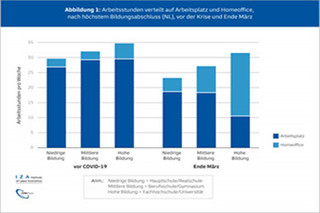Home office and the same salary even in the Coronacrise? This is not possible for all employees in times of crisis. Economists from the ECONtribute Cluster of Excellence in cooperation with the Research Institute for the Future of Work (IZA) surveyed around 5,500 Dutch people between 20 and 31 March 2020 on the changes in their working environment during the pandemic. Clearly: More highly qualified employees spend more time in the home office, while less qualified employees are forced to reduce hours or risk losing their jobs altogether. The ability to have a home office is a question of the level of education. This is confirmed by new data from the COVID Impact Lab, a new research project of the ECONtribute cluster of excellence: Markets & Public Policy in cooperation with the Institute for the Study of Labor. The researchers compared the changes in the world of work around the beginning of the crisis - before it had an impact on working life and shortly after government measures restricting the exit from the crisis came into effect. For the first time, it is now possible to show with figures how the proportion of employees who carry out their daily work from home has changed.
The home office benefits higher earners
The proportion of employees who worked at least two hours a day in a home office doubled from 27 to 54 percent. But not every employee can use home work to the same extent: Among highly qualified employees, 76 percent stated that they worked at least two hours from their home office after the crisis began. Among the low-skilled, only 31 percent do so. Among academics, the switch to the home office is also the norm: the proportion of home-based work increases here from 11 to 68 percent. Among the less educated employees, however, the home office share of weekly working hours increases to only about one-fifth, and their total number of hours decreases much more than among academics.
The losers of the crisis on the labour market are low earners
The reason for this may be that less qualified people work more often in occupations where they cannot do their work in the home office, such as transport, retail or catering. Persons at the lower end of the income distribution are also hit twice as hard: not only do they have to reduce their hours more than higher earners. It is also to be expected that these reductions in hours will be more difficult for them to cope with, as they have fewer reserves to compensate for the losses of the coming months. They will therefore need government support more than other income groups. Another part of the less qualified work in systemically important professions, such as nursing or food retailing. Although they currently have a secure job, they are exposed to an increased risk of infection. In contrast, workers in the home office are doubly protected - from infection and loss of income. The division of sectors into office occupations that are characterized by high skills and home office work rates and those that are low is very clear.
Transferability also to Germany
"For Germany there are no comprehensive data available yet, but initial tendencies in the same direction are becoming apparent. Although the increase in the home office appears to be somewhat lower than in the Netherlands, it is clear that non-academics are also lagging behind here and cannot carry out their work from home. Moreover, both the Netherlands and Germany have similar restrictive restrictions in everyday public life, which creates a similar basis," says Hans-Martin von Gaudecker, ECONtribute Professor of Applied Microeconomics at the University of Bonn and head of the IC research team Structural Policy Evaluation, explaining the results.
Impact Lab with current data on the crisis
Together with his research team from Bonn and the Dutch University of Tilburg, the economist wants to analyse the effects of the current crisis and the measures to counteract it. To this end, he has, together with other scientists, set up the COVID Impact Lab. The aim is to quickly generate helpful data in the current crisis and make it available to the public and decision makers. In the medium term, more in-depth analyses are then to be carried out. The project is supported by the Cluster of Excellence ECONtribute: Markets & Public Policy Cluster of Excellence.
